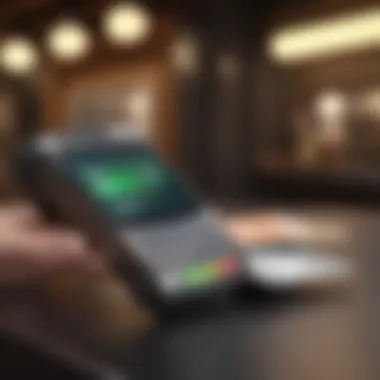Receive Payments on Your Phone: A Complete Guide


Intro
In today's fast-paced world, the ability to receive payments directly on your phone is not just a convenience; it's becoming a necessity. Whether you are a freelancer seeking prompt compensation, a small business owner gathering customer payments, or simply someone who prefers the ease of mobile transactions, understanding the landscape of mobile payments can open up new spheres of possibilities. The rise of digital technology has paved the way for various platforms, apps, and methods to facilitate this process, making it easier than ever to embrace cashless transactions right from the palm of your hand.
This guide aims to peel back the layers of mobile payment solutions. We shall navigate through the multitude of options available, weigh their pros and cons, and delve into the nuances of security measures that are crucial in this digital age. No matter where you fall on the spectrum of expertise—whether you are just starting or have a well-thumbed knowledge of mobile transactions—you are bound to find useful insights that empower you to make informed choices.
By uncovering the complexities of mobile payments, readers can better understand not only how to optimize their payment collection methods but also the undercurrents of technology and safety that come into play. Let’s dive deeper into this fascinating arena where convenience meets innovation.
Intro to Mobile Payments
In recent years, mobile payments have shifted from a mere convenience to a necessity for many. With the rise of smartphones and the increasing reliance on digital platforms, understanding mobile payments is no longer just for tech enthusiasts or millennials; it’s become a fundamental skill for everyone. For those keen on receiving payments directly through their phones, grasping the ins and outs of mobile transactions is paramount. It breathes life into the way we handle finances, allowing users to conduct business or manage personal transactions at the touch of a button.
The Shift to Digital Transactions
The world, as we know, it is moving at breakneck speed toward digitization. A decade ago, cash ruled the roost, and checks were still a common form of payment. Fast forward to today, and many folks hardly remember the last time they withdrew cash from an ATM. The trend began subtly with the introduction of credit and debit cards but has now leaped into the realm of mobile devices. The convenience of sending and receiving money with just a few taps is a game-changer. Statistically, studies indicate that nearly 70% of people use mobile payment methods in some form. This staggering statistic showcases just how imperative it is to understand mobile payment functionalities.
Among the factors driving this shift are advancements in technology and growing trust in security measures. The pandemic nudged many bricks-and-mortar businesses to adapt swiftly to mobile transaction systems, further communicating that to stay relevant, one must change with the times. Notably, young consumers, often referred to as digital natives, are leading this charge. Their preferences have pressured businesses and service providers to prioritize customer-centric solutions that fold into their digital lifestyles seamlessly.
Benefits of Mobile Payments
Implementing mobile payment solutions offers a plethora of benefits:
- Convenience: Making payments via a mobile phone allows for swift transactions without the hassle of searching for cash or waiting in line at a bank.
- Accessibility: The capability to access your funds anytime, anywhere, empowers users, especially those on-the-go. This can be especially true for individuals running businesses, freelancers, or anyone who manages their finances outdoors.
- Tracking: Mobile payment apps often come with built-in features to track spending, providing the user clear visibility into their financial health.
- Enhanced Security: Contrary to popular belief, mobile payments tend to be more secure than traditional methods. Biometric features like thumbprint or facial recognition add an additional layer of protection, reducing fraud risks.
In addition to these benefits, there exists the possibility of rewards programs. Many digital wallets and payment apps offer cash back or loyalty points for using their services, which is akin to getting free a coffee with every few purchases. Overall, adopting mobile payment methods can not only simplify your financial dealings but also enhance your general quality of life in the digital age.
Understanding Mobile Payment Methods
Understanding mobile payment methods is a cornerstone of navigating the current financial landscape. As we shift towards a more digital economy, it becomes crucial for users to familiarize themselves with the various platforms and methods available for receiving payments directly on their phones. Customers expect convenience and speed, and capturing those expectations means embracing the best tools the market has to offer.
Delving into the specifics of these methods not only broadens one’s capacity to handle transactions but also enhances one’s financial literacy, which is vital in today’s rapidly changing economic environment. With a myriad of choices on the table, knowing how to select the right mobile payment solution based on personal needs and the nature of the transactions is invaluable.
Bank Applications
Bank applications have become the backbone of mobile payments for many individuals. Most banks today offer user-friendly apps that not only allow you to check your balance but also enable instant payments or transfers directly from your account. They often include features like check deposits via your smartphone’s camera, which can save you a trip to the bank.
The importance of maintaining a direct connection between your bank and mobile payments can’t be understated—it offers security and reliability. Mobile banking apps often use strong encryption and biometric authentication, such as fingerprints or facial recognition, to shield your information. As an added benefit, most bank apps provide real-time notifications that alert you to any activity in your account, helping you stay on top of your finances.
Digital Wallets
Digital wallets, like Google Pay or Apple Pay, have emerged as popular choices among those who wish to streamline their payment processes. These wallets store payment information securely, allowing you to make quick transactions without needing to carry cards or cash. This is particularly useful in today’s fast-paced world, where efficiency is a key selling point.
Features like contactless payments and loyalty card storage add further allure to digital wallets. Picture this: walking into a store, scanning your phone, and walking out in mere seconds. With growing merchant acceptance, using a digital wallet can often feel like a futuristic approach to shopping, eliminating the clutter of traditional wallets, too.
Payment Apps
Payment apps are a game changer, especially for peer-to-peer transactions. Applications like Venmo and Cash App allow users to send money instantly to friends and family with just a few taps on their screens. They have honed in on the social aspect of transactions, creating a more engaging experience where sharing bills and splitting expenses feels less like a chore and more like a casual interaction.
However, while convenient, one ought to be conscientious regarding transaction limits and potential fees for faster transfers. Additionally, always know that when engaging in a transaction via these apps, safety should be a priority; ensure you’re dealing with trusted contacts to avoid unwanted surprises.
Cryptocurrency Payment Options


Cryptocurrency payment options, such as Bitcoin, are becoming increasingly relevant in mobile payments. More businesses begin accepting cryptocurrencies as forms of payment, offering an alternative that appeals to tech-savvy individuals and those inclined towards decentralized finance.
Some apps are specially designed for crypto transactions, allowing users to buy, sell, or trade currencies right from their phone. It’s essential to recognize that while this form of payment can be lucrative for investments, it also carries volatility and security risks, therefore it's advisable to educate oneself on the nuances before diving into this realm.
"The rise of mobile payment methods reflects a significant change in how we exchange value, likely setting the stage for new economic paradigms in the years to come."
In summary, each mobile payment method offers its own set of perks and challenges. Understanding these tools and knowing when and how to use them will empower users to navigate this evolving financial frontier successfully.
Popular Payment Platforms
When we talk about mobile payments, the platforms you choose can make or break your experience. It's like having the right tool for the job—if you've got a toolbox stuffed with junk, you might end up making a mess instead of fixing things properly. Utilizing popular payment platforms not only enhances convenience but also ensures that transactions are seamless and secure. Moreover, these platforms often come with features that cater to different needs, whether you're a freelancer getting paid or a business owner managing sales.
PayPal and Its Features
PayPal remains one of the giants in the payment industry. It’s been around for a while now, and it shows no signs of slowing down. One of its most appealing features is its wide acceptance. Just about everyone has heard of PayPal. You can pay for items on eBay, shop from various online retailers, and even send money to friends without hitting anyone's radars.
- Ease of Use: Setting up an account is a piece of cake. All you need is an email address.
- Protected Transactions: PayPal offers buyer protection, which means you can dispute a charge if something goes wrong.
- Sending Money Abroad: It supports international transactions, making it handy for those who need to send money overseas.
The only downside can be transaction fees, especially when sending money as a business. You'll want to keep an eye out while using PayPal for larger transactions.
Venmo: Connecting Friends and Payments
Venmo takes a more casual approach to支付. It's as if your friend just forwarded you the beer money for that night out. While it may seem laid-back, it's become an essential tool, particularly for younger users.
- Social Feed: Venmo’s social element allows users to share payment activity with friends, which might seem unnecessary but adds a sense of community.
- Instant Transfers: You can transfer your Venmo balance directly to your bank account quickly, making it super easy to access your funds.
However, keep in mind that Venmo isn't meant for business transactions. Using it for businesses could result in account limitations or a ban.
Square and Point-of-Sale Solutions
Square distinguishes itself as a powerhouse for small businesses trying to manage transactions. It’s not just a payment app; it’s a whole ecosystem. You can use Square to set up a point-of-sale (POS) system in your shop or even take payments on-the-go with a card reader.
- Inventory Management: It offers rich features like inventory tracking and sales analytics.
- Online Store: You can easily create an online storefront.
- Flexibility: Whether you have a brick-and-mortar location or you’re a food truck vendor, Square’s got you covered.
For entrepreneurs, Square allows a rare flexibility, which is essential in a fast-changing retail environment.
Cash App: An Overview
Cash App is like the shiny new toy in mobile payments. Developed by Square, it offers a mixture of personal and business features. Cash App is famed for its user-friendly interface, making it ideal for those who might feel overwhelmed by financial technology.
- Cash Card: Users can request a Cash Card that links directly to their Cash App account. With this, you can access your funds easily.
- Invest in Bitcoin: Cash App even allows you to buy, sell, and send Bitcoin.
The potential for cryptocurrency integration is crucial, especially for those looking to dip their toes into that space.
"Keeping up with the technological wave in finance is crucial. Those who adapt will thrive, while others may find themselves swimming against a current they can’t control."
Setting Up Payment Solutions
Establishing a mobile payment solution is more than just a few taps on your phone; it lays the groundwork for your financial transactions in the now-dominant digital landscape. Setting up payment solutions entails creating an account with a payment processor or linking your existing accounts to various apps. Done right, this can open up avenues for quick transactions and the convenience we’ve all come to expect in this fast-paced world. Let's break it down so that you can get the best bang for your buck and ensure smooth sailing in your mobile financial endeavors.
Downloading and Creating Accounts


To start with, you need to choose the right platforms that align with your needs. Whether it's Venmo, PayPal, or Cash App, downloading the application is your first step.
- Check Compatibility: Ensure the app is compatible with your phone's operating system. Most of the popular ones work seamlessly with both Android and iOS.
- Download the App: Head to the App Store or Google Play Store and grab the app. Installation typically takes just a moment.
- Account Creation: Once the app's up and running, you’ll be prompted to create an account. This usually involves entering your email or phone number, followed by setting up a secure password. It can feel a bit tedious, but ensuring your account is locked down is worthwhile in the long run.
Creating that account may seem straightforward, but always pay attention to verification steps. Many platforms often require phone number verification or an email confirmation to ensure you are who you say you are. Be mindful of providing accurate information, as this affects your transaction process down the line.
Linking Bank Accounts and Cards
With your account ready, it’s advisable to hook up your bank accounts or cards to enable seamless transactions. Linking your financial accounts may feel a bit intimidating, but it’s vital for the functionality of any payment solution.
- Navigating to Settings: Within the app, locate the settings or payment section. This area generally allows you to manage linked accounts.
- Select Your Bank or Card Type: Most platforms let you add various accounts, from checking and savings accounts to credit cards. Choose what best suits your financial habits.
- Input Your Details: Enter your bank account number or card information. Make sure to double-check your entries.
- Verification Process: After entering your details, many services will either do an instant verification or send a small amount to your account as a test.
Tip: Use a bank or card that you mainly rely on for seamless transactions. Reliable connectivity makes it hassle-free when you're sending or receiving money.
It’s crucial to use only secure networks when linking these accounts to prevent unauthorized access. Protecting your sensitive information should always be top of mind.
Understanding Transaction Fees
Once you’ve set everything up, understanding transaction fees is equally important. While some platforms are upfront about their costs, others may have hidden charges that can sneak up on you.
- Standard Fees: Each platform has different standard fees based on transaction types. Instant transfers, for example, often come at a cost, whereas standard transfers may be free but take longer.
- Cross-Border Transactions: If you’re dealing with international payments, be aware of currency conversion fees that may apply.
- Promotional Deals: Some platforms waive fees for promotional periods, so keep an eye out for offers. However, read the fine print, as these can change quickly!
Understanding these fees is essential not just for effective budgeting but can also affect how often you use an app. Knowing when a transaction incurs costs can save you a pretty penny in the long run.
In summary, setting up your mobile payment solutions isn’t just about convenience; it is about creating a seamless flow of your financial activities. Each step—downloading, linking accounts, and knowing fees—joins the pieces together for a robust mobile payment strategy. Keep a keen eye on your accounts, and you'll set yourself up for success.
Safety and Security
In the world of mobile payments, safety and security come out on top as paramount concerns. With technology moving at high speed, ensuring that transactions remain secure is vital for both individuals and businesses. A misstep in this area can lead to identity theft, unauthorized transactions, and loss of trust in these systems. As financial enthusiasts and individual investors navigate this landscape, understanding how to protect oneself while using mobile payment solutions should be a top priority.
Risk Assessment of Mobile Payments
When it comes to mobile payments, assessing risks is like checking your parachute before jumping out of a plane. Various threats lurk in the digital shadows, waiting for the unprepared. These risks include:
- Phishing Scams: Criminals often mimic legitimate services to extract personal information. This can happen through fake emails or malicious apps.
- Malware: Downloading apps from untrustworthy sources might lead to harmful software being installed unknowingly.
- Data Breaches: As with any online service, mobile payment platforms can be vulnerable to breaches that compromise user data.
To mitigate these risks, diligent users must stay alert and informed. Frequent monitoring of financial statements and utilizing security alerts can help catch suspicious activity early on. Additionally, selecting trusted applications with a solid reputation prevents falling prey to many of these common pitfalls.
Best Practices for Secure Transactions
Engaging in mobile transactions shouldn’t feel like tiptoeing through a minefield. Instead, it should be a straightforward process managed with thoughtful strategies. Here are some of the best practices aimed at maximizing security:
- Use Strong Passwords: A password is your first line of defense. Utilize a mix of letters, numbers, and symbols, and change them regularly.
- Enable Two-Factor Authentication: This extra step—often a simple SMS code—adds more layers of security.
- Keep Apps Updated: Developers frequently push updates to patch security vulnerabilities. Ensure your apps are always up to date.
- Monitor Transactions Regularly: Keeping an eye on your financial movements can help catch anything that seems out of the ordinary quickly.
"Prevention is better than cure. Staying informed and cautious is always advisable when dealing with your hard-earned money."
- Set Privacy Settings Wisely: Make sure you understand the permissions you grant to each app. Limit unnecessary access to your data.
- Be Wary of Public Wi-Fi: Avoid making transactions over unsecured networks. If you must, consider using a VPN to encrypt your connection.
Implementing these strategies can significantly enhance protection against threats while enjoying the convenience that mobile payments offer. It might seem tedious, but taking these precautions can save both money and stress in the long run.
Challenges of Mobile Payment Solutions


Navigating through the mobile payment landscape is like wandering into a bustling market. It's vibrant and filled with opportunities, yet fraught with challenges that can trip even the most seasoned buyers. Understanding the hurdles in mobile payment solutions is essential, as it not only guides users in their payment journey but also ensures that transactions are smooth and secure.
Technical Issues and Limitations
When it comes to mobile payments, technology can be both a blessing and a curse. On one hand, the convenience of tapping your phone to make a purchase is unparalleled; on the other, technical glitches can put a damper on the experience. Several technical issues persist:
- Connectivity Problems: A shaky internet connection can lead to failed transactions, creating frustration for users. You might find yourself in the middle of a checkout, only to have the internet drop like a hot potato.
- Device Compatibility: Not every mobile payment app works seamlessly across all devices. Android users may find it tough to use some apps that are optimized for iOS, leading to a fragmented user experience.
- Software Bugs: Occasionally, apps may experience bugs that can hinder functionality. If the app crashes while you're in the process of making a payment, it may leave you feeling unsure about whether your transaction went through.
These hiccups can deter users from fully adopting mobile payment solutions, opting instead for more traditional methods. As the technology evolves, addressing these technical limitations becomes imperative.
User Adoption Struggles
Another layer of complexity adds to the issue of mobile payments: user adoption. Despite the clear advantages, some folks remain hesitant, primarily due to lack of familiarity:
- Digital Literacy Gap: There’s a substantial portion of the population that’s not comfortable using digital tools. Older generations, in particular, might be reluctant to trust their financial information to their mobile phones. Their experiences may lead them to view such technology with suspicion.
- Fear of Fraud: Security remains a hot-button issue. Users often worry about the safety of their sensitive information and potential fraud. A single news story about a data breach can greatly influence public perception and trust in mobile payment apps.
- Complexity of Usage: Some payment platforms can be overwhelming, with features that may confuse the everyday user. If the setup takes longer than anticipated, or if it's not intuitive, many will likely abandon it altogether.
"For every roadblock encountered in mobile payments, there are opportunities for innovation and improvement."
Thus, to bridge this gap, companies must focus on education and streamlined experiences to win over hesitant users. Ensuring that mobile payment systems are user-friendly and secure can very well tilt the scale in favor of wider acceptance.
The Future of Mobile Payments
As technology barrels forward, the landscape of mobile payments continues to evolve at a breathtaking pace. This section takes a closer look at what the future holds for how we transact, the innovations on the horizon, and how these shifts are set to revolutionize user experience.
Emerging Technologies
With the advent of increasingly sophisticated technologies, the potential for mobile payments to grow and adapt is closer than ever. Surging ahead are several key innovations:
- Blockchain Technology: Many see blockchain as a game changer. By providing a decentralized ledger, it offers security and transparency that’s hard to match. Individuals and businesses alike can execute transactions without a middleman, potentially cutting costs and enhancing trust.
- Near Field Communication (NFC): While already in use, the future of NFC is promising. This technology allows users to tap their phones against a terminal to make payments instantly. What’s on the drawing board? NFC-enabled wearables and smart devices could widen accessibility for those seeking speedy transactions.
- Artificial Intelligence: It's creeping into mobile payments, offering personalized experiences based on user behavior. Imagine apps that analyze your spending habits, helping you budget better or even suggesting savings based on patterns seen in your transactions. It's information at your fingertips.
More importantly, these technologies aren't just trends—they're the building blocks for a more integrated and secure payment ecosystem. As they develop, innovations such as biometric payments could emerge, enabling users to authenticate transactions with mere fingerprints or facial recognition. This might sound futuristic, yet it’s on the brink of becoming reality.
Changing Consumer Habits
The way people handle their finances is changing drastically, influenced by rapid technological advancements. The younger generations, in particular, are steering this shift with their digital-first mindset. Here are some trends in consumer behavior shaping the mobile payments future:
- Preference for Contactless Payments: The pandemic has accelerated the adoption of contactless payments, with many consumers now favoring apps and systems that ensure a swift and hygienic transactional experience. It’s not just about convenience; it’s about feeling secure while shopping.
- Growing Interest in Cash Alternatives: With increasing awareness of the risks associated with cash handling, more consumers are opting for digital transactions. The comfort and familiarity of methods like Venmo and PayPal are pulling in even those who were once hesitant.
- Demand for Seamless Experiences: People today expect smooth, hassle-free transactions. Whether it's shopping online, splitting bills, or sending money overseas, users want minimal steps from initiation to completion. This hunger for immediacy is prompting developers to streamline services constantly.
An interesting factor to consider is that loyalty programs and incentive schemes are increasingly being integrated into mobile payment systems, enticing consumers to stick with particular platforms. This loyalty could reshape the competitive landscape as businesses vie for users by offering the best experience.
In summary, the future of mobile payments is poised for transformation, driven by both tech innovations and shifts in consumer behaviors. As we adapt, so will the tools available to us, making it essential for users to stay informed in an ever-evolving marketplace.
Closure
The conclusion of this guide serves as a pivotal point that succinctly ties together everything we’ve explored concerning mobile payments. As the world marches towards an increasingly cashless society, understanding mobile payments becomes essential not just for convenience but also for financial literacy. This article presents a well-rounded view of mobile payment options, their features, and the importance of security practices, emphasizing how users can protect themselves while engaging in digital transactions.
Recap of Key Takeaways
- Diverse Methods Available: There’s a variety of mobile payment methods out there, from bank apps to digital wallets and payment applications. Each has its unique features and suitability depending on what users need.
- Importance of Security: Users must be keen on security practices. Every payment method comes with its own set of vulnerabilities, so implementing best practices can help mitigate risks.
- Emerging Trends: Technologies like contactless payments and cryptocurrency are shaping the mobile payment landscape. Staying updated with these trends is vital, especially for those wishing to leverage mobile payments fully.
- User Adoption: While convenience is a strong selling point, the challenges of user adoption are real. Many individuals still prefer traditional payment methods, so understanding these hurdles can aid in better outreach and engagement.
Final Thoughts on Mobile Payment Viability
In sum, the viability of mobile payments is undeniable. They offer swift transaction methods that are efficient and adaptable to different consumer needs. For financial enthusiasts and individual investors, embracing these technologies can lead to smarter transaction methods and improved oversight of finances. As we navigate a rapidly changing financial landscape, integrating mobile payments into our everyday practices may very well be the key to staying ahead.
"The future of financial transactions lies within your palms, and adapting to this digital age will equip you with a competitive edge."
To learn more about the trends and technologies shaping the future of transactions, check out articles on Wikipedia, or get engaged in conversations about mobile payments on Reddit.
Utilizing these insights will surely prepare anyone to successfully traverse the mobile payment world.















